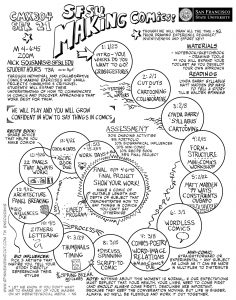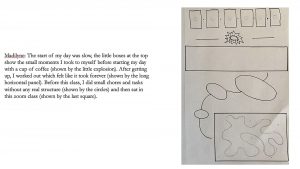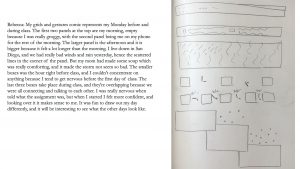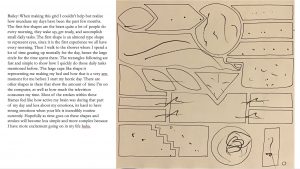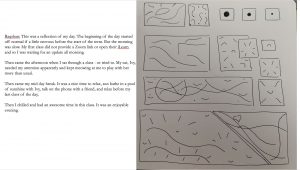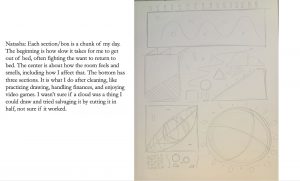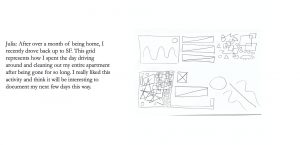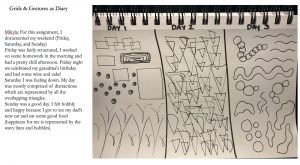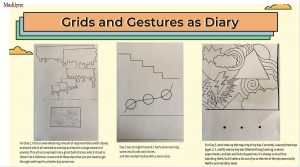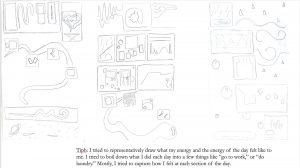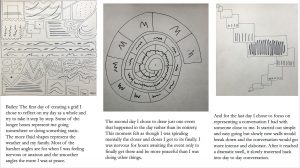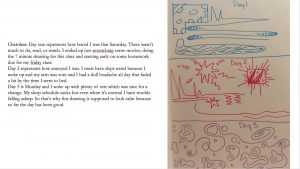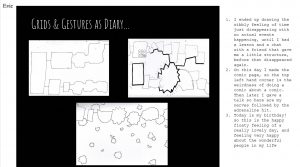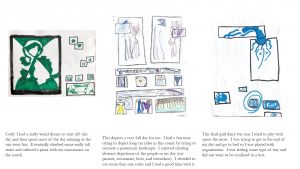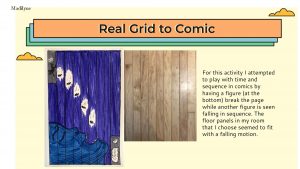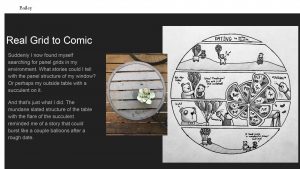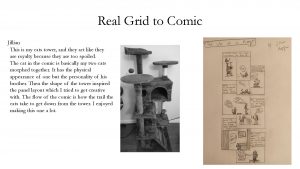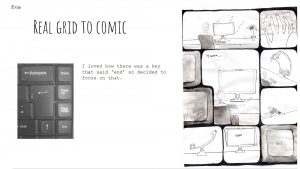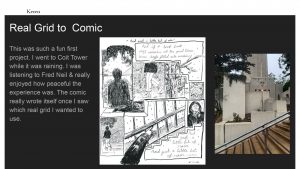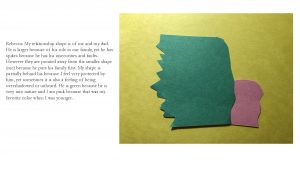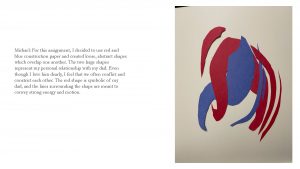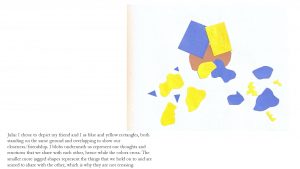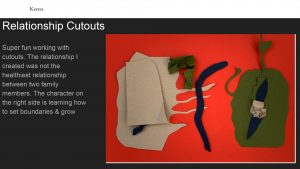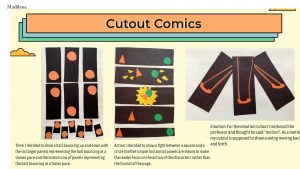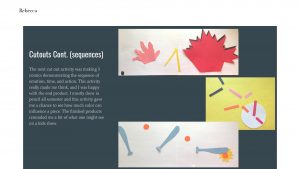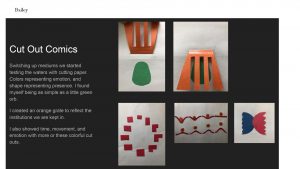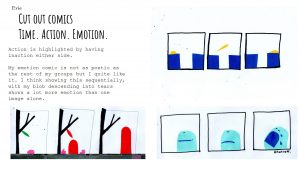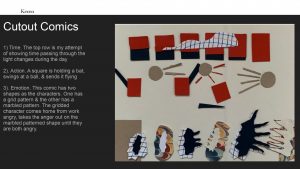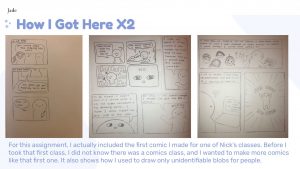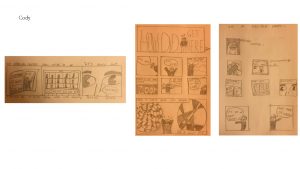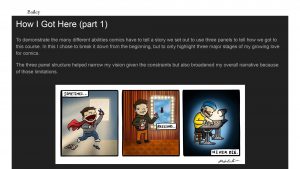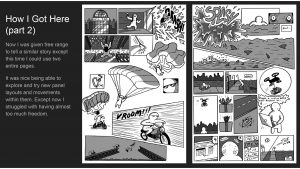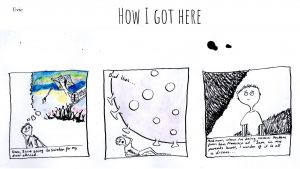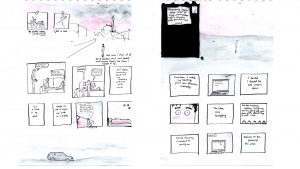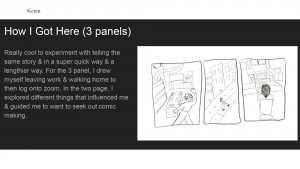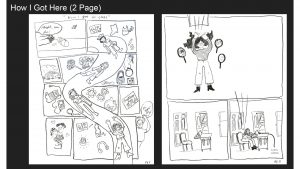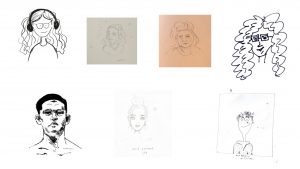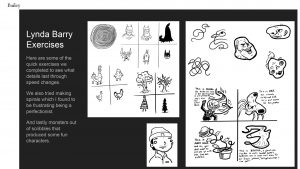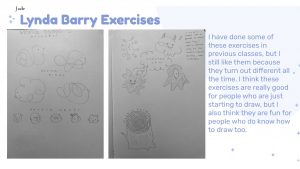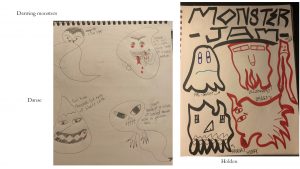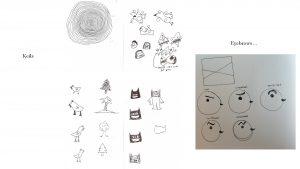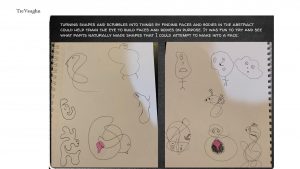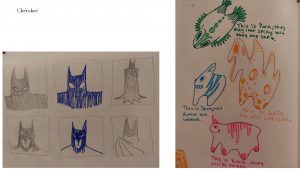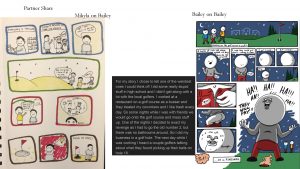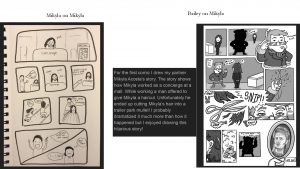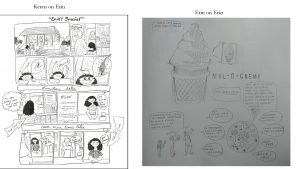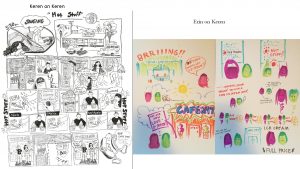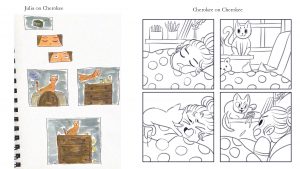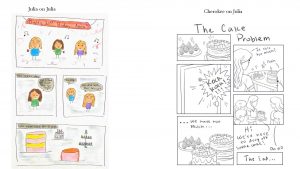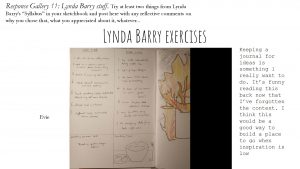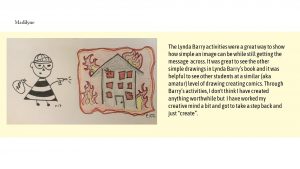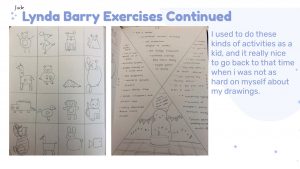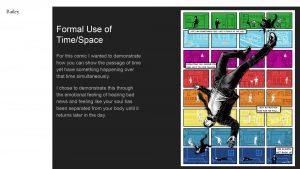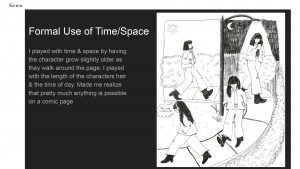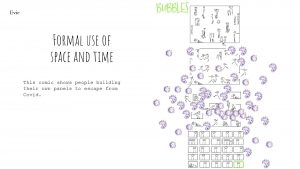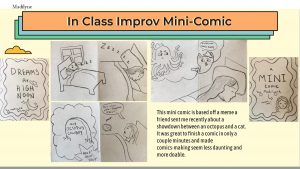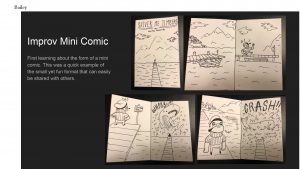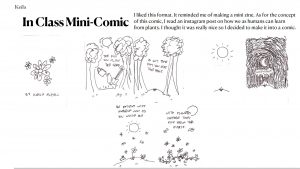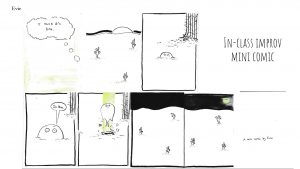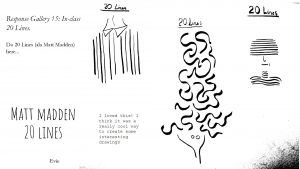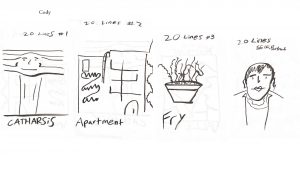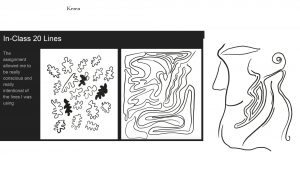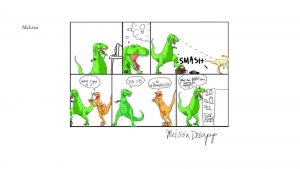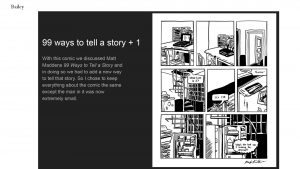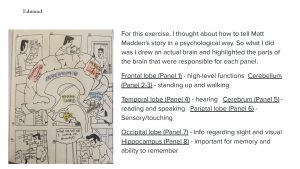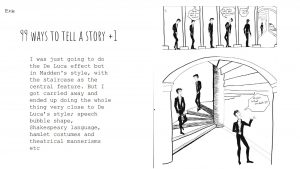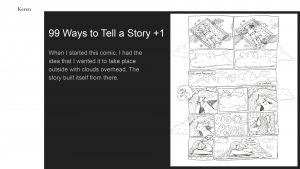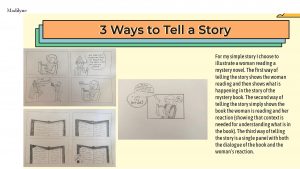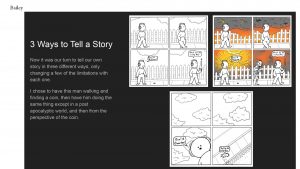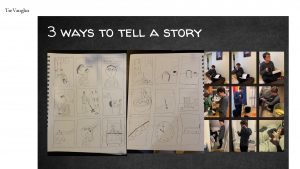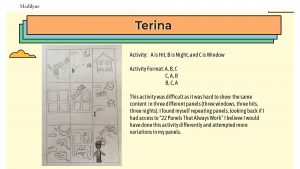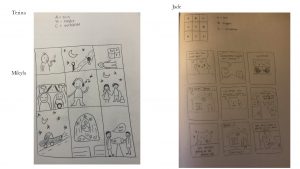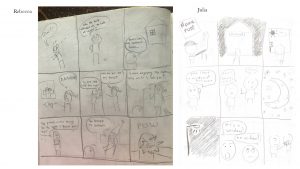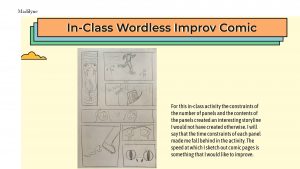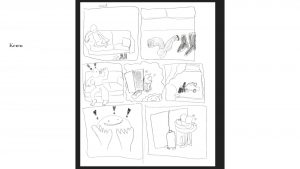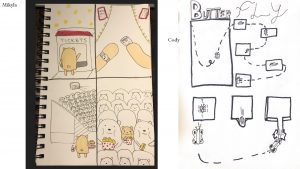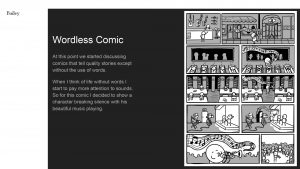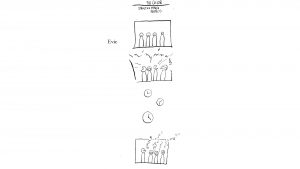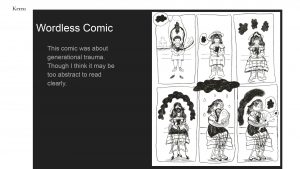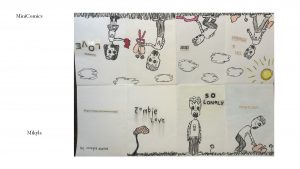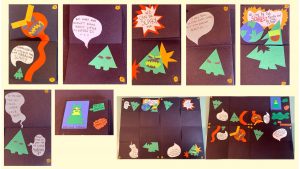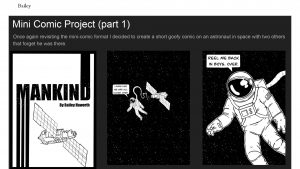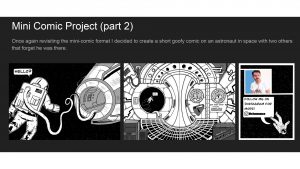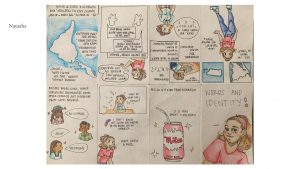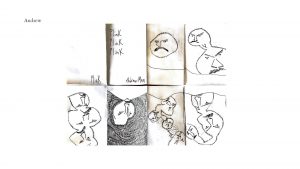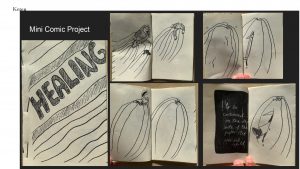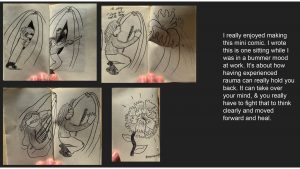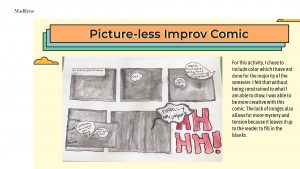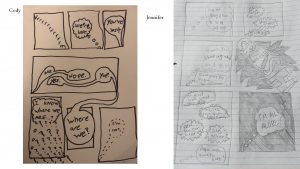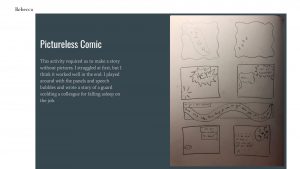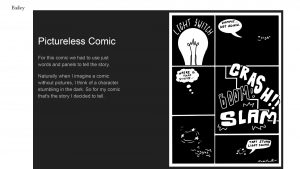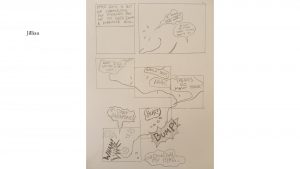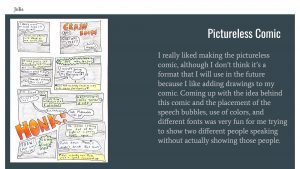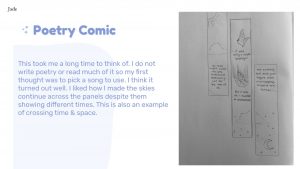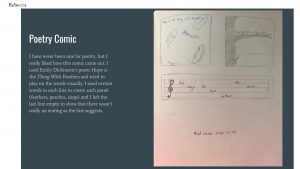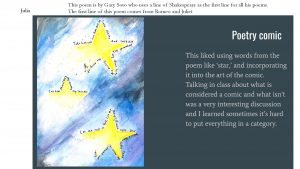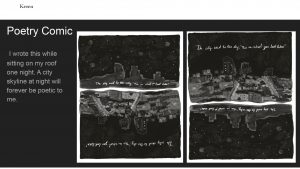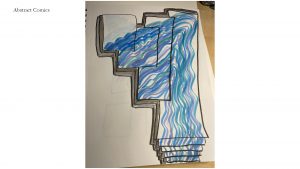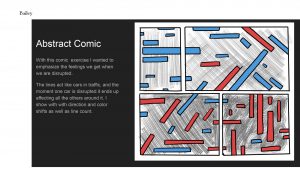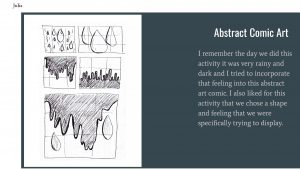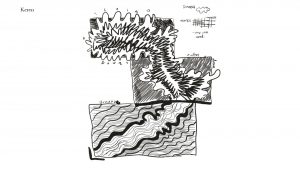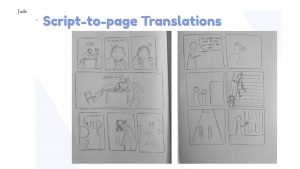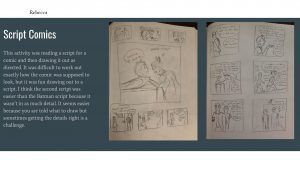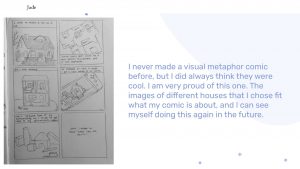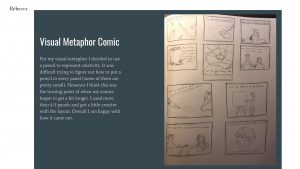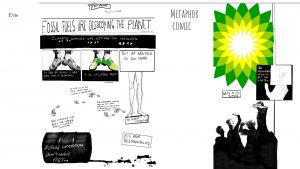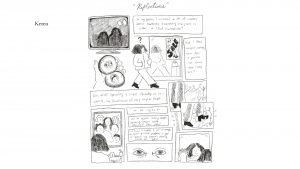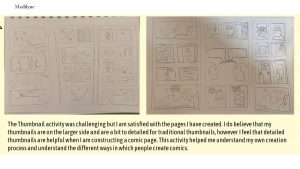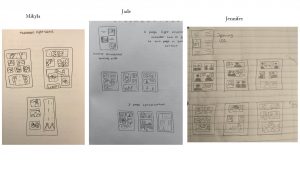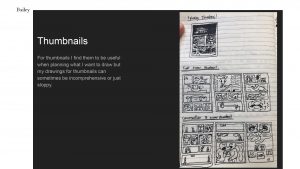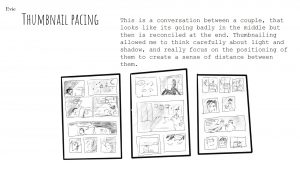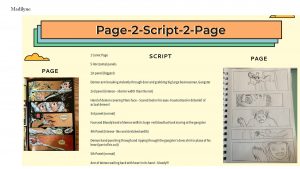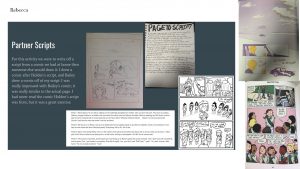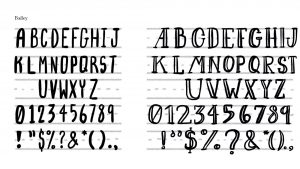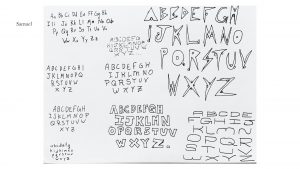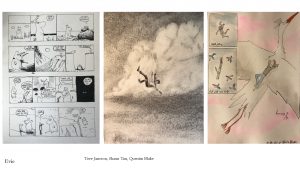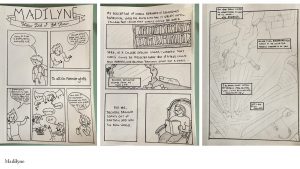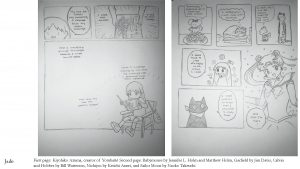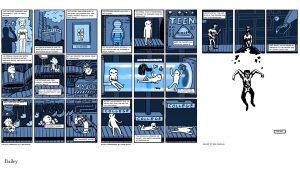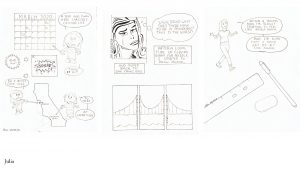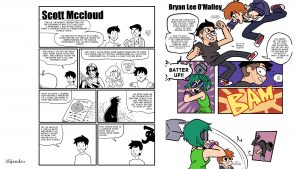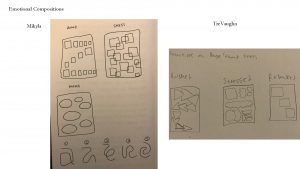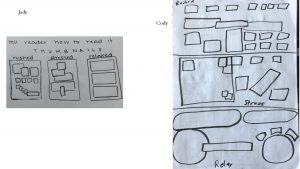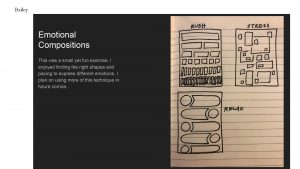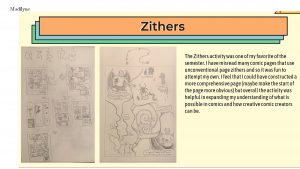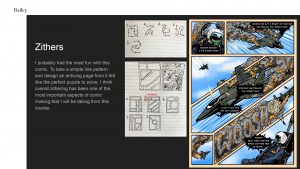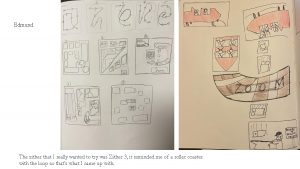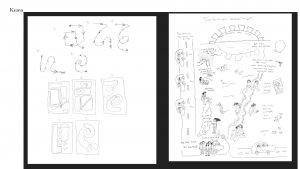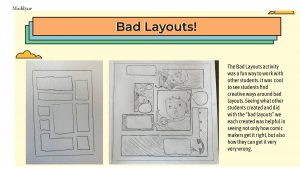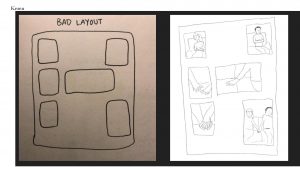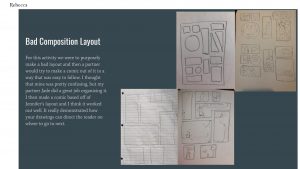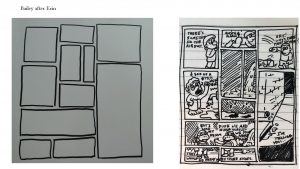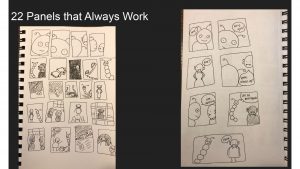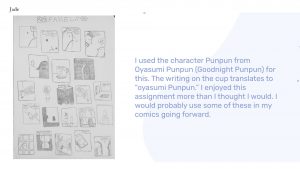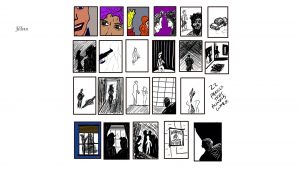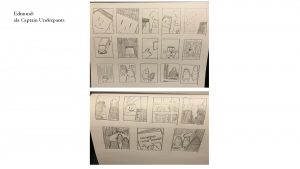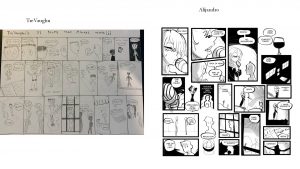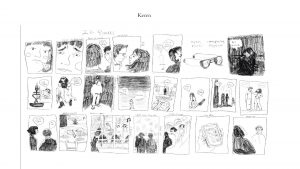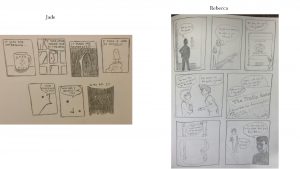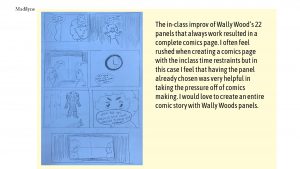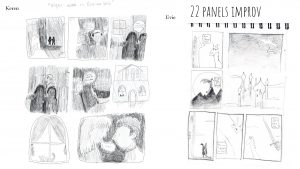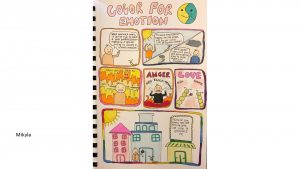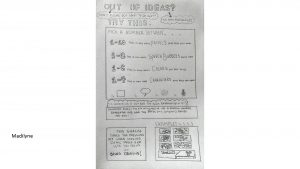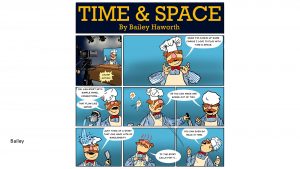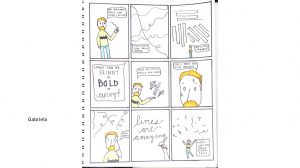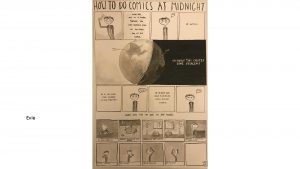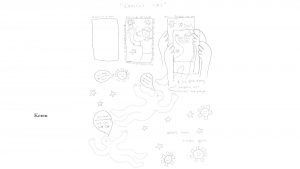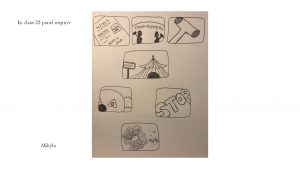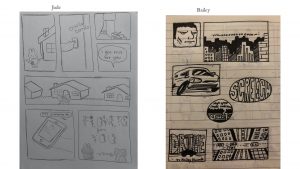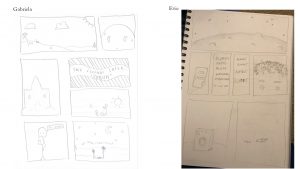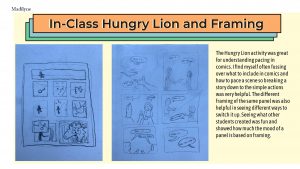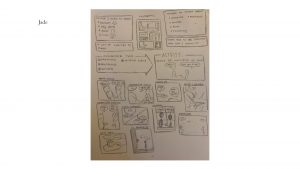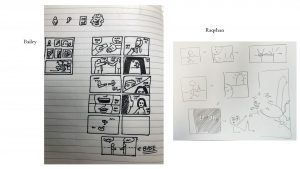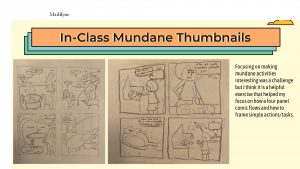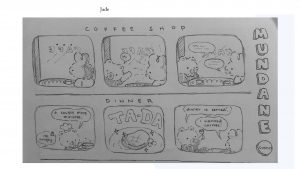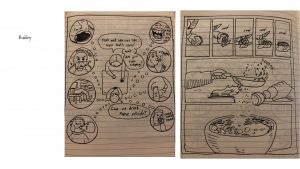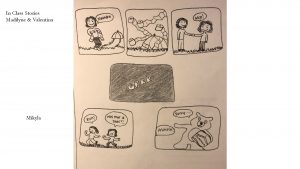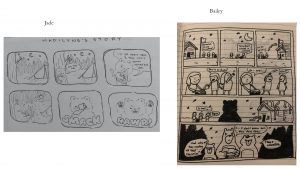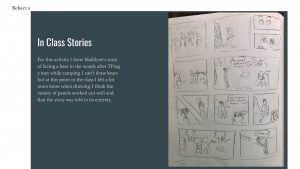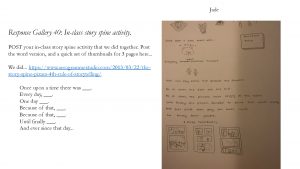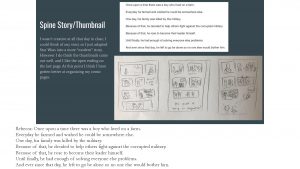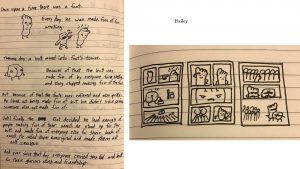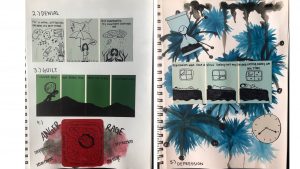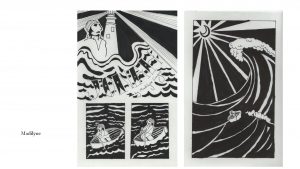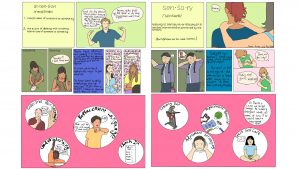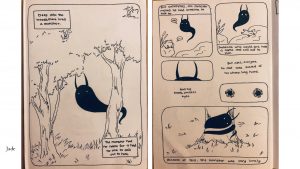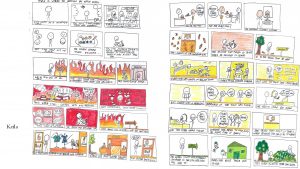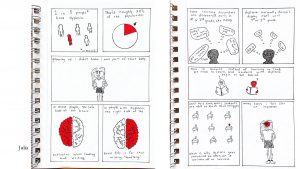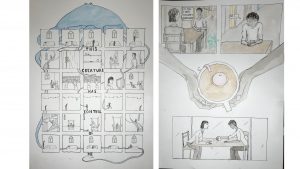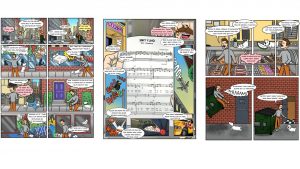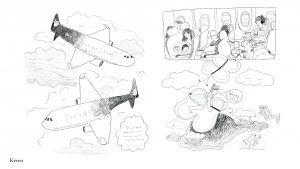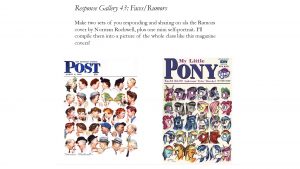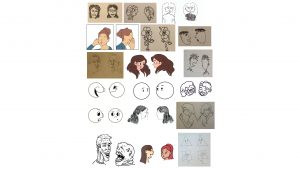CMX304 Making Comics Spring 2021 What We Did
(See ALL my syllabi & resources on my Comics-Education landing page here)
This is a COMPLETE account of EVERYTHING we did in my Making Comics class S2021 – online on Zoom. I do a ton of collaborative activities in in-person classes. That had to be adapted somewhat for the online environment – passing papers from student to student wasn’t particularly practical – so I modified and came up with a lot of new in-class activities using constraints as a way of self-collaboration. Despite the difficulty of the circumstances, this course and the Fall 2020 version prior, came together really well and student work was absolutely outstanding! I get a mix of students who’ve never drawn or made comics before and then those who come with an art background of some sort – all of them did terrific work and grew leaps and bounds. Presented below is a quick summary of what we did each session (though my slide talks and PDFs I made for students are not shared at the moment, you’ll have to imagine…), then the activities we did in class and for homework or larger projects. For each one of those, I’ve compiled student examples that show the range of ways students approached the activity. With some of them, I’ve also included their reflections on the activity – either collected from their online posts or the portfolios they created end of term, where they put together everything they did over the term. I’m showcasing ones that nailed the activity in some way – some because they made amazing comics, others because it showed they learned something with it (And some I chose simply for clarity of the scan of their image).
One more note, before we get to it, I tell them at the start of the term that they shouldn’t expect to make a 40 or 60 page comic over the semester – that’s too much and not realistic. But, if they do all the activities we try over the term, if they play, they will have created at least that many pages of comics and will have learned and grown an extraordinary amount. To that point, a student (Julia) wrote in her portfolio:
“Although I was told I would be creating a lot of work this semester I was in disbelief until I went through each comic again while putting together this portfolio. Although not every comic came out the way I wanted it to, I saw every comic as an opportunity to learn what I liked and didn’t like about my work. I think I have grown a lot this semester and had a lot of fun looking back over all my work.”
What follows is first the visual syllabus and key parts of the text version (you can download the syllabus in full as a (PDF) here), then a breakdown of what we did in each class. With each assignment, I’ve included a few excerpts of student work directly on the page, and then PDFs with more of the work (often a few activities are compiled into a single PDF). I hope this is of some use to others looking to try their hand at teaching a comics course or to give yourself a crash course in making your own! – Nick
[I compiled a similar set of everything for the 2018 version of this class. That is all available here.]
- Required Reading:
- Matt Madden 99 Ways to Tell a Story
- Lynda Barry Syllabus
- Tillie Walden Spinning
Recommended Texts: Comics making is a highly individual and idiosyncratic activity. To that end, we will have no particular “how to” text for the course. However, here are some texts that discuss elements of craft and theorize on the ways in which comics can say things in ways other media can’t that we will draw on in the course. I recommend acquiring at least one over the term that you find particularly insightful.
-
- Scott McCloud Understanding Comics& Making Comics
- Matt Madden & Jessica Abel Writing Words & Drawing Pictures & Mastering Comics
- Ivan Brunetti Cartooning
- Will Eisner Comics & Sequential Art
- Nick Sousanis Unflattening
- Old School Bonus! Stan Lee & John Buscema: How to Draw Comics the Marvel Way
Required Materials: Since we will regularly be drawing and making comics in this course, it goes without saying that you will need to have basic drawing materials. You will be responsible to build up your own tool set as you develop your particular approach to comics making, but I’ve listed the bare essentials here.
-
- A notebook/journal/sketchbook of some sort
- Drawing tool of your choice (pen, pencil, brush pen, etc.) (Color options are nice too)
- A Note about Now: Let me acknowledge to start off, nothing about our current circumstances is normal, and our expectations must reflect that. As understanding as I typically am about deadlines and workload in normal times, I’ll be even more so now. Your health, your lives, need to come first (and should always come first), and we can work out solutions for whatever is going on (preferably with a good channel of communication). I want to see the work we do together as helpful to what you are experiencing and not an added burden. This doesn’t mean we won’t work hard and that it won’t be challenging, just that it serves you as something meaningful and relevant to find your own ways into it. Deadlines are important, because they allow us to keep the conversation moving and keep learning from one another, but life is bigger, always, and definitely now, so I’ll remain flexible and we’ll work it out together.
- I’m intending to keep the course synchronous, to preserve the dynamic, interactive, and frequently collaborative atmosphere that has been so key to these classes, but all will be recorded, all instructions and resources will be available on iLearn, and there will be no penalty for not being able to make a session. We can check in outside of class, and make sure everyone is up to speed no matter their circumstances. Let’s see this course and my role as being there to support you in where you are going. With that said, on with what we’ll do together…
Overview: Introduction to the hands-on making of comics. Students will engage in numerous in-class exercises and small projects in making comics alongside analysis of comics, in order to grow their understanding of how to communicate in comics and discover methods that best work for them.
Course Outline: Through instructor-led in-class and at-home individual and collaborative exercises, students will learn basic methods of constructing a page, developing a narrative across multiple pages, and a variety of formal issues that go into the creation of comics. The ultimate project for the course will be the creation of a short comic demonstrating your growth over the term. Students will also assemble (online) portfolios to showcase their finished projects, process, and to learn about growing an audience for their work.
To further our making skills, we will also analyze and absorb techniques and approaches gleaned from a wide variety of comics produced around the globe and throughout history, focusing on their unique or outstanding (and occasionally reproachable) formal qualities. Additionally, we will delve into comics theory and practice to explore how different creators/theorists articulate their working methods (including authors like Scott McCloud, Matt Madden & Jessica Abel, Lynda Barry, Ivan Brunetti, Will Eisner, Kevin Huizenga, and me).
Philosophy: We will play and you will grow confident in how to say things in comics.
Day 1: Intro, Grids & Gestures (1/25/21): On this day, we laid out where we were going, got to know one another a bit, discussed the importance of thinking through drawing and that comics were a form available to anyone to work in, and got started with our comics making through my Grids & Gestures activity in class.
[A note about Response Galleries: these are online spaces where students post their in-class exercises and homework projects – with scans of the work and often some brief words about the process. Often the RG will appear the week after we actually talk about a subject, as that’s when we share what they did. I was doing this before the move to virtual class, so it was pretty easy to keep doing that. It’s also why I have such a complete account of what was done by everyone over the term.]
Response Gallery 1: Why Comics/Your Experience/You… For this entry (as you will do with all of them), where it says “Concept” enter your last name first, first name last, and then under “Definition” write a brief reflection of what your interest in in comics/what brought you to this class; then list three favorite comics authors (and maybe what comics you’re reading now if any); next – say a few words about what you hope to get from this course; finally – say a bit about your experience (if any) making comics and drawing. Post a picture of you – to practice posting and remind us of who everyone is! And, if you’re feeling ambitious, I’d like you to post a sample or two of something you’ve made along these lines and from one of your favorite authors. [For obvious privacy reasons, I have not included examples of this activity – but you get the idea.]
Response Gallery 2: Grids & Gestures (in-class) Post your grids & gestures non-representational comic from Monday’s class and write a brief reflection about what’s going on in your comic and any other thoughts that you have on making it. G&G explanation This is a quick video I made explaining grids & gestures. I have a more detailed one on my site with some more resources, www.gridsgestures.com, but this is a good test of putting video on iLearn! 🙂
Day 2: Cutouts & Cartoons (2/1/21): In which we reflect on Grids & Gestures, play with cutouts, and think about cartoons (which we would do more of the following week)… I do cutouts because I find it liberating – can’t be too fussy, with a few cuts you create shape and volume. It’s a great place to start. We build on what they learned from doing G&G – this means how much they already know about drawing (jagged edges hurt, smooth curves feel good, and so on), how much they learned about time and space in doing the exercise, and I’m guided by Molly Bang’s wonderful book Picture This, as well as such things as Crockett Johnson’s Harold and the Purple Crayon, Paul Klee’s Pedagogical Sketchbook, Serge Bloch’s The Big Adventure of a Little Line, Lakoff and Johnson’s Metaphors We Live By, some book called Unflattening, and more. We then segued to working in cutouts with construction paper, and also looked at Norton Juster’s The Dot & The Line animated by Chuck Jones, Heider & Simmel Experimental Study of Apparent Behavior .
- Norton Juster’s The Dot & The Line animated by Chuck Jones on YouTube or on Vimeo
- Heider & Simmel Experimental Study of Apparent Behavior https://www.youtube.com/watch?v=n9TWwG4SFWQ
- Kiley Hamlin animation experiment Helpers & Hinderers
- Cutout Paper artists:
- Maëlle Doliveux
- Mita Mahato website, and her Poetry Comic “Lullaby”
- The Adventures of Prince Achmed 1926 cutout animation
- How to Brand a Film Saul Bass Style
- Delightful video interview with designer Paul Rand
- Designer/Comics Artist Mark Gonyea
- the Jack & Jill problem(activity)
Response Gallery 3: Grids & Gestures as Diary. Do Grids & Gestures at home 3 times over the week – spending about 7 minutes each time. See how your days differ, how your approach differs, etc. Post all three here with any comments you want to share.
Response Gallery 4: Real Grid to Comics. Observe some architectural composition in your world – a building, windows, a street layout, floor tilings, the dashboard of a car, whatever – find one you are inspired by, take a picture of it, then make a single comics page based on the composition of the actual architecture. Post both the image of the architectural element and your comic here.
More complete PDF of Grids & Gestures, Grids & Gestures as Diary, and Real Grid to Comic activities
Day 3: Lynda Barry (2/8/21) Today, we looked at Lynda Barry’s approach to teaching comics, looking at examples from Syllabus (which they all read)and Picture This, thought about cartooning as an organic process, and then drew connections between our work with lines and cutouts to how cartoons work – which includes looking at images of faces everywhere (i.e. electric sockets), Töpffer via EH Gombrich “illusion of life which can do without any illusion of reality: lack of elaboration guarantees the absence of contradictory clues. – perform a kind of closure”, McCloud on the power of cartoons, why Peppa Pig works, and Ivan Brunetti’s “eyebrow” expressive drawing exercise. From there we did a lot of fast drawing activities including Barry’s exercises like drawing Batman and monsters, “Boids” and other such things. I find that Lynda Barry’s works are fantastic for helping reluctant drawers rediscover what they knew before they were seven. We mostly try activities from her work and let them try more on their own. Kickstarts a lot of students thinking in new ways… They were left to spend time with Syllabus and pick out some favorite projects from it to do and share back the next class.
- Lynda Barry’s Teaching Tumblr(http://thenearsightedmonkey.tumblr.com)
- Videos (!) of Lynda Barry Teaching http://www.openculture.com/2019/06/cartoonist-lynda-barry-teaches-you-how-to-draw.html
- Lynda Barry @ the Wisconsin Institute for Discovery& Lynda’s author page at Drawn & Quarterly
Response Gallery 5: Relationship Cutouts. Post your relationship cutout from class here – along with a brief description of what you did and what choices you made… Think about some relationship that you know of (you and another person, a pet, an organization, a subject, or another person and their relationship(s) – whatever you do, base it on something real and something of some significance. Create a cutout that relates the parties by the shape you cutout, the color, and how you organize the space between the different elements. Share a brief description of what you did and what choices you made…
Response Gallery 6: Cutout Comics. Post your cutout comics from class here – demonstration the following using 3-6 panels for each prompt: 1) time 2) action 3) emotion, along with a brief description of what you did and what choices you made… If you want an extra prompt and to keep cutting – you can also do the Jack & Jill prompt (or your own variation on it) that is linked to on iLearn. Big Selection of Cutouts & Cutout Comics PDF
Response Gallery 7: How You Got Here x2. Simple comics making exercise – tell the story of how you got here – this class (Interpreted however you feel like…) in a 3 Panel strip and then again in a 2-page comic (divided into as many panels as you wish). Post up here with any comments about the process you wish… PDF of big selection of How You Got Here activities
Response Gallery 8: In-class self portrait. Post your two-minute self-portrait from the start of class. We did a lot more of these over the term, this seems to be one of the only ones I actually documented.
Response Gallery 9: Stuff we did in class! (2/8/21). Post some of the things we did in class today and some reflections, Monster drawings, Batman-speed drawings, the spiral, any of it you wish with comments… We did a number of different quick drawing/cartooning activities in class including: Boids (draw a curly, looping shape at random – then intentionally add one triangle and one small circle or dot as a beak and an eye respectively to transform your shape into a bird), “lumpies” (draw potato-y, amorphous shapes, and then give them features), Lynda Barry activities: Monster drawings, Batman-speed drawings, the spiral, and we probably did more…
Day 4: Form & Structure + Mini-Comics (2/15/21) Today we talked some of the formal properties of comics, the affordances they make available, and then we concluded with a workshop on making mini-comics for our upcoming mini-comic project. Specifically, I took them on a long slide talk discussing the Affordances of Comics – concerning structural composition, from McCloud and Eisner’s characterization of comics as sequential art, to looking at how time occurs in space in comics, to the notion of simultaneity, which is prominent in my thinking on comics and draws on Thierry Groensteen and others. Talked about the power of flat surfaces, how comics are drawing and meta-drawing (the composition), how flat surfaces allow all sorts of spatial adjacencies – comics are thus an act of drawing and meta-drawing (considering the whole page) at the same time – thus you can do weird things that can only happen in comics. We looked at weird ways comics do things, lots of examples of panel breaking of different sorts, and mentioned comics’ “flippability” as coined by Kent Worcester. Specific readings include: Richard McGuire’s original 6-page version of Here: A short rather bland comic, but one of the most influential in comics history for its demonstration of what comics could do and Moore & Veitch How Things Work Out: Fascinating use of the comics page to manipulate time…
Additionally we did a mini-comics making workshop – looking at instructions for straight-forward methods of making them as well as examples of unusual formats.
- Mini-comics resources on my website – scroll down http://spinweaveandcut.com/making-tools-and-minicomics/– PLEASE explore!!
From my listing – some key straightforward guides:
Abel & Madden template/instructions
Jessica Abel’s extensive mini-comic making guide
Response Gallery 10: Partner-Share Comic. (As we did in class) Share a brief vignette/story of something that happened to you with your partner. Each person then makes a comic representing their partner’s story and their own story – so TWO comics in total created by each person. Post each story here labeled as to who you’re working with.
Response Gallery 11: Lynda Barry stuff. Try at least two things from Lynda Barry’s “Syllabus” in your sketchbook and post here with any reflective comments on why you chose that, what you appreciated about it, whatever…
Click here for a PDF compiling activities above: self-portraits, class-stuffs (monsters, lumpies, etc.), Partner-share comic, and Lynda Barry stuff.
Response Gallery 12: Stuff we did in class (2/15/21). POST a few of the things we did in class with any comments you want to share..
Response Gallery 13: Formal Use of Time/Space. For this exercise, create a short comic that makes use of the spatial nature of comics to do something unusual in the storytelling that could ONLY be done in comics. We’ve talked about the idea of simultaneity in comics, looked at examples of panel breaking and the role the very structure of the panels can have in the storytelling, as well as the strange play with time in Here and How Things Work Out. Play around with it, have fun with it and see what you come up with!
READINGS
- Structure Overview (PDF) On comics as sequential art, the weirdness of time/space in comics, and simultaneity across the page…
- Moore & Veitch mind-bending short comic (PDF): Better format than other version I posted. “How Things Work Out” from Greyshirt in America’s Best Comics #2 by Alan Moore and Rick Veitch.
- Richard McGuire “Here” (PDF): A short rather bland comic, but one of the most influential in comics history for its demonstration of what comics could do…
Day 5: Matt Madden Day (2/22/21) Today we will look at Matt Madden’s 99 Ways to Tell a Story and try some constraint-based exercises he’s invented. I love Matt’s book because it shows just how much is possible in comics in an entirely non-didactic way. It allows the interested reader to discover for themselves all the possibilities a comics page presents…
We also discussed this: Typically: Comics ~ Prose & Illustration, But perhaps, better to say (as the Canadian cartoonist Seth suggests) Comics = Poetry + Graphic Design.” This set up the discussion of constraints in comics, and specifically Matt Madden’s 99 Ways to Tell a Story and try some constraint-based exercises he’s invented.
- Additional list of constraints Matt came up with and didn’t use
- Matt Madden’s blogpost on Tic Tac Toe Jam Comics making game
- Matt Madden’s list of other comics-making constraint games
- Matt’s 20-Lines drawings
- Oubapo site
- Kristen Haas Kurtis diary constraint game http://www.hellomizk.com/bythebones
- Terina activity! https://mattmadden.com/2018/09/06/notes-from-the-labyrinth-report-1-jason-robinsons-one-two-punch/
- Paul Kirchner’s The Bus comic with introand here https://imgur.com/a/S3k3C#0
Excerpts from Christian Bök’s Eunoia http://poemsandpoetics.blogspot.com/2009/07/christian-bok-excerpts-from-eunoia.html
Response Gallery 14: in-class improv mini-comic. In class, we made a mini-comic together – finish with the Title/cover – and whatever you want on the back page, and POST here!
Improv mini-comic rules: Do the Cover Last! – we’ll come back to that at the end…
Each page can act as a single panel – or – you can divide pages into multiple panels if you choose.
Here are some prompts to include across the pages of your mini-comic.
[Stuck on any step – close eyes, make random squiggly mark on page – use it as part of your composition… *Consider doing the prompts for different pages out of order]
-
- Imagine a moment in the future, for example 6 months/twenty years from now: Draw something that sets the scene. Draw a character (perhaps like we did earlier). How do they feel in this moment? Where are they? Draw their environment.
- And then what happened? Pick out some object that you can see in the room you are in, and incorporate it into the narrative
- Use a Major camera change – zoom in close-up/zoom out – big scene
- Find a recent text/message on your phone – incorporate it into the narrative. The text can be a line of dialogue, thought, narrative caption, sound effects, background noise, on a billboard, book jacket…
- A page or panel with no words or images, just marks or textures—create a mood
- OR Try a panel or page with only words or sound effects, no pictures
- Make a time jump – flashback/leap forward in time
- ENDING – finish story however you want
- Do the Cover – Add a TITLE and relevant imagery to capture essence of your tale. Don’t forget to add byline!
Click here for PDF Compiling time/space comics and the improv mini-comic activity
Response Gallery 15: In-class 20 Lines. POST your 20 Lines (ala Matt Madden) here…
Response Gallery: 3-person collaborative comics [DID NOT DO – doesn’t work on zoom very well] POST here the finished comic begun in class and list the names of the other two people who worked on it. Recall from class (and for those of you who missed it) – the first person drew a blank page composition/panel layout, the second person added the words and word supports (balloons, thought bubbles, caption boxes, sound effects, …) – and you were to take it home to draw whatever is going on in your comic. Look forward to how these came out!
Day 6: Wordless Comics (3/1/21) Today, we did some constraint-based activities and looked at wordless comics from old woodcut wordless novels to modern comics employing wordlessness in a range of ways. Some specific comics we looked at include Peter Kuper’s The System, Erik Drooker’s Flood, Shaun Tan’s The Arrival, Sara Varon’s Robot Dreams, and even not quite wordless books like David Small’s Stitches, to see how limiting words could be used to great effect. Also looked at some of David Berona’s scholarship on wordless comics.
- READ: Articles and Comics below (PDFs) all on Wordless comics
- Giacomo Patri “White Collar” at SFSU http://digital-collections.library.sfsu.edu/cdm/compoundobject/collection/p16737coll1/id/386
- Berona on Wordless Comics – Drooker (PDF): on Erik Drooker’s wordless comics and more…
- Berona on Wordless Comics (PDF): mostly on Peter Kuper’s the System
Response Gallery 16: 99 Ways to Tell a Story +1… After exploring Matt Madden’s 99 Ways to Tell a Story, pretend that you are adding one more page to it. Take his original concept page – the base one – and make your own variation in a way that he didn’t already do in the book. Post here with any comments you might have.
Response Gallery 17: 3 Ways to Tell a Story Playing off of Matt Madden’s 99 Ways book, make a one page comic of your own run of the mill story. Then, do TWO more versions of it (for THREE in total), 1) where you play with STYLE 2) play with STORYTELLING (sequence, structure, etc.), and/or 3) distort FORM (things that may no longer even be comics by our definition). Pick two of these strategies – or do all 3 if you want to. Push yourself to be inventive and really question the very structure of conveying a narrative. Excited to see what you all come up with! Post here and explain your constraints briefly.
Here’s a PDF of ALL the Matt Madden-related activities we did.
Jack Kirby Faces – for self-portrait warmup! [Not sure if we did this…]
READING: Wordless comics folder with selection of wordless comics…
Response Gallery 18: Terina In class, we tried a constraint-based activity called a Terina – POST what you came up with here. You can see more about the Terina activity here https://mattmadden.com/2018/09/06/notes-from-the-labyrinth-report-1-jason-robinsons-one-two-punch/. For our constraints A = Hit, B = Night, C = Window. Curious to see how these came out!
Response Gallery 19: In-class Wordless Improv Comic. In class, we did a wordless improv comic with the following set of rules:
0) Draw a page with seven panels
Panel 1) Draw something that sets the scene and the mood…
Panel 2) spot an Object in your room, and incorporate it into the narrative
Panel 3) Some sort of message from off panel, mediated through a device, out a window, something – is received (still wordless) and causes excitement/elevates dramatic tension.
Panel 4) A flashback – what happened before
Panel 5) Draw characters/scene in silhouette
Panel 6) Close-up
Panel 7) Wildcard… finish however you want…
Day 7: Word-Image, Comics Poetry (3/8/21) in which we discussed word-picture relations in comics to start – drawing on Moore, McCloud, Eisner, and tons of examples on how words are used in comics as narrative to the visual of balloons and sound effects. Then we turned to discuss comics-poetry – what it is and looked at many examples from comics and outside (things like blackout poetry and Calligrams). I had them check out the comics-poetry anthology inkbrick and read the links and short comics below. We also looked at Abstract Comics and did an activity around that.
- Check out and please READ Alexander Rothman’s interview “What is Comics Poetry”.
- Also, Julian Peters comics adaptation of The Love Song of Eliot’s J. Alfred Prufrock https://julianpeterscomics.com/page-1-the-love-song-of-j-alfred-prufrock-by-t-s-eliot/)
- On Abstract Comics
Response Gallery 20: Wordless Comics. Create a short wordless comic (1-3 pages) that plays with some of the ideas we looked at in last class in discussion and in the various wordless comics we explored. Think about what you substitute for dialogue, think of ways to use text or invented text, how to give enough clues to create clarity while remaining wordless – and so, available to someone not speaking your language. Let’s make it wordless, but not silent – that is people are talking, etc… Check out the articles I posted for last week, specifically the one on Berona’s analysis of Peter Kuper’s The System. He offers 5 ways that authors do things in wordless comics that I’d like you to think about and try to incorporate into yours. Make your comic and post here with a few words about some of the things you tried (either outlined in the article or your own invention)
Here’s the PDF compiling more examples of Terina, Wordless improv, and wordless comics
Response Gallery 21: Mini-Comic Project. This is one of our three mini-projects that are graded and expected to be worked to a greater state of completion than the quicker activities we do all term. Make either a straightforward or experimental mini-comic on any subject as long as you can make it in multiples to distribute. We’ll workshop formats, design, and look at a range of examples prior. Here, post a scan of your mini-comic project (and any comments you wish to share). I recommend posting a template version and a version that is easily readable in booklet form. Looking forward!
Here’s a PDF of Many more of the Mini-comics
Response Gallery 22: Picture-less improv comic. 7-panels picture-less 1 page comic
Instructions: You may draw up the 7 panels before you start or as you go. Panel will have no drawings in a representational sense – this is a comic made of panel borders, words, word supports (word balloons, thought bubbles, captions, SFX), and emanata (symbols emanating from a character (unseen in this case) that indicate some sort of internal state). The comic must use at least 7 of following as you see fit (if you want more randomness to it, roll a die to see which option you use for each panel, but this is not necessary!). You may use multiple options in a single panel, and you may invent a new option (please name it!):
-
- word balloon or other dialogue device
- Shouting dialogue/whispering dialogue
- Other multimodal form of dialogue (icy text, overly friendly, … )
- play with where the word balloon tails come from/shaped like…
- A narrative caption
- A sound effect
- Sound effect or balloon that transgresses panel borders
- Thought balloon
- Title lettering (ala Eisner’s The Spirit and certainly Krazy Kat as well…)
- Some bit of words gleaned from a recent text message or similar on your phone
- Emanata (symbols emanating from a character (here unseen) giving insight into internal/emotional state
- Sound/voice coming from outside setting – mediated by phone, radio, zoom, something that indicates it is transmitted from elsewhere
- Panel in the shape of a word?
- Hint at what’s been unseen in all the panels…
Here’s a PDF of a ton of examples of the pictureless improv activity – they were all so good!
- Comics Poetry Overview (PDF)
- Image Text overview (PDF) Some of the slides on words & pictures and their interactions in comics that I went over in class…
Day 8: Script-to-comic process + Spinning (3/15/21) We’ll be thinking about how scripts are translated into finished pages… [Spinning was scheduled for this day, but i bumped it back a session] The second half of class, we look at how comics scripts are translated into finished pages. (We are moving into the more technical part of the semester now…) This involved me giving them the script to a page from a Sandman script written by Neil Gaiman and a page from the Killing Joke (Batman) written by Alan Moore and then comparing what they came up with the actual published pages. I also set up the Visual Metaphor comic project for later.
- On word-image interaction:
- The “Rabbit” page, with Key: http://spinweaveandcut.com/rocky-mt-comics-conference-and-rabbits-at-glc/
- On the genesis of my “Rose” page: http://spinweaveandcut.com/rscon5-visualizing-references-and-behind-the-scenes-sketches/
- A bit about the evolution of my own process http://spinweaveandcut.com/my-evolution/
Response Gallery 23: Poetry Comic. Try your hand at a short piece of comics poetry as observed in class and on www.inkbrick.com. You may invent your own comics poem, or adapt an existing poem or song, but we want to stress that you push away from doing a straight representational piece and really think about the use of the form and the specific interaction of words and pictures to get your meaning/feeling across. Looking forward to what you come up with!
Response Gallery 24: Abstract Comic Exercise. POST your abstract comic activity from class. The prompts were to select: kinds of shapes, kinds of marks, overall page composition, select a mood. You can add additional constraint/prompts if you choose. Post with any reflective comments you care to share.
Here’s the PDF compiling more Poetry & Abstract Comics!
Response Gallery 25: Script-to-Page Translations. We took a page of script from the Sandman and Killing Joke respectively, and tried our hand at each one. Then compared to the actual pages as printed.
- READINGS: Sandman script excerpt; Killing Joke script excerpt
Day 9: Telephone-Timing-Thumbnails + Spinning (3/29/21). In today’s class, we discussed Spinning and talked about thumbnails and timing. In typical times I would play more expansive telephone games with scripts and thumbnails – I had to truncate that due to how difficult it is to collaborate online. We looked closely at how artists create thumbnails. Also, explored timing – specifically how artists use their lower right corner before a page turn to generate interest – and then created an assignment where we worked backward from pacing choices. First thing we did was do a 3 page fight scene with back and forth between protagonist and villain, cliffhangers bottom right and some resolution by last page. Did same thing for a conversation with similar kinds of ups/downs, highs/lows as seen in RG28.
Response Gallery 26: Analysis of a page from Spinning. Pick a page you like from Spinning – and quickly redraw it and diagram all over it – how it works, how she makes meaning – notice all the cool stuff about it and POST here to prompt discussion.
Response Gallery 27: Visual Metaphor Comic. Ok, so in class we looked at how comics scripts become comics pages – textual description translated into visual depiction. For this assignment, I want you to try a piece where words and images co-generate one another. First, have a look at “This is Information” by Moore and Gebbie that we’ve looked at and I’ve posted on iLearn just below. Then look at the following comics or pages by me: (see below for a PDF of these things)
-
- Show of Hands http://spinweaveandcut.com/show-of-hands/
- The Rabbit Page: http://spinweaveandcut.com/rocky-mt-comics-conference-and-rabbits-at-glc/
- Maxine Says: http://spinweaveandcut.com/in-print-maxine-says/
- Seeing Red/Feeling Blue http://spinweaveandcut.com/on-view-seeing-red-feeling-blue/and
- the Rose page from Unflattening: http://spinweaveandcut.com/rscon5-visualizing-references-and-behind-the-scenes-sketches/
You are to make a one-page multi-panel comic where you select a single thematic element (along the lines of what I’ve done in the examples) to use literally/metaphorically throughout as a way of linking the piece together. A short way to think about is to talk about one thing in terms of another (i.e. talk about games by talking about rabbits, talk about democracy by talking about hands, comics as roses, etc.) Keep your metaphor running in some way for each beat of your narrative. Take this in whatever direction you need to – and have fun with it!
-
- Moore & Gebbie This Is Information (PDF). One of the comics that most inspired my particular way of working – a six-page comic created as part of a 9/11 tribute book.
- Metaphor Project (PDF): A quick slideset of some of my work to give you ideas to create your own visual-verbal metaphor comics!
- Visual Analysis examples (PDF): have a look at these to think about how you analyze a page from spinning…
Response Gallery 28: Thumbnail pacing… In class, we worked on thumbnails and pacing and thought about page turns. We started by reverse-engineering a thumbnail from Spinning. Then in class we create a quick 3-page thumbnail story depicting a fight scene, where we made sure the bottom right corner panels of p1 and p2 had a dramatic/page turning moment, where page 3 ended with resolution, and there were ups and downs, changes of advantage, those sorts of things. Then, at home, you are to do that again, but this time with a conversation (argument, whatever), same kind of rules as with the fight scene. If you want to pick one of these and do an additional rough sketches of the sequence to greater completion, that’s up to you. I posted examples of thumbnails in a PDF below.
Thumbnail overview (PDF) A look at some of the examples I shared…
Day 10: Thumbnails & Lettering (4/5/21) Quick review of word-picture interaction, SFX, and balloons, and then looked specifically at lettering (which is not handwriting!) drawing on works from Abel & Madden, Kevin Huizenga’s class books, McCloud, and guidelines and tips from professional letters – plus thought about title lettering including of course Eisner’s Spirit title pages.
Response Gallery 29: Page-2-Script-2-page exercise. In class, we took a comics page, made a script, and someone else made a comics page from the script. Post the 3 steps here…
Response Gallery 30: Key Alphabet. Develop your own key alphabet, practice your letter forms for lettering your comics. Try a couple times and post a set here with any notes you want… See the Lettering Overview PDF for support on this.
Full examples in the PDF from script-to-page, thumbnails, visual metaphor, key alphabet here.
Lettering Overview (PDF)
Some key slides and thoughts from our slide talk in class on lettering – as not handwriting but Drawing!
Day 11: Architecture and Zithers (4/12/21) This week, we looked at your autobiographical influences comics, talked about the Recipe Book, architecture, and explored emotional compositions, the “Zithers” exercise – where I draw a directed squiggle of some sort – and then they have to layout a page that follows the reading path of that squiggle – using page composition, characters, word balloons, whatever – to move the reader’s eye in the way I randomly drew.
To help prep you for the autobiographical influences project, have a look at these examples…
- READ (or at least skim): my comic “bi(bli)ography” http://spinweaveandcut.com/bibliography-final-version/
- READ pages from R Sikoryak’s Masterpiece Comics
- READ: about R Sikoryak’s iTunes Terms & Conditions adaptation https://www.drawnandquarterly.com/terms-and-conditions
- READ some pages from Sikoryak’s Terms & Conditions by scrolling here: https://itunestandc.tumblr.com
- READ (or at least look at): my comic “A Life in Comics” http://spinweaveandcut.com/greene-anthropocene/
- Comics theorist Neil Cohn twitter thread on the importance of copying to learn to draw!
Response Gallery: Project 2 – Autobiographical Influences. Make a short comic about yourself by using at least three instances where you directly reference the style from 3 different artists (comics or related) that you admire or were influenced by as a way to tell your narrative. Play with it, see if it gives you any ideas about your own drawing process, your style, composition ideas. It’s a chance to learn a bit about your own comics making by adopting the look of others. See my example “bi(bli)ography” and R.Sikoryak’s “iTunes Terms & Conditions” adaptation – all of which I linked to above… Have fun with it!
Click here for more autobiographical influences examples in PDF
Response Gallery 31A: Emotional Compositions. in class we did compositions for “rushed,” “stressed”, and “relaxed” – post here (one page if you can) with any reflection you care to share!
Response Gallery 31: Zithers. our in-class “Zithers” exercise. POST your five thumbnail solutions to these reading paths, and then pick your favorite thumbnail of the five, and do a finished page from it. POST thumbnails and the finished page here. I’m adding a bit here for extra explanation: Design a comics page in which the reading path follows the drawn curve by using whatever affordances of making comics that you can bring to it: panel layout, word balloons/captions, sound effects, figures crossing panels/outside of panels, background imagery – whatever you come up with. I would prefer it not to be a snake/chutes and ladders gameboard sort of thing – that’s a little too easy. You can see more examples here http://spinweaveandcut.com/making-zithers/
Response Gallery 32: Final Project Proposal. Post a short description (100-150 words) of what you plan to do for your final project, including form, length, subject matter, any other specifics about the work, and feel free to post any images if necessary to help explain what you have in mind and its feasibility so I can give you feedback.
Day 12: 22 Panels That Always Work… (4/19/21) An exploration of “Wally Wood’s 22 Panels that Always Work” – we look at many versions of this by Wood and other artists, make our own, and then turn it into a game where I randomly draw 7 numbers from a hat, and they draw those panels as a collaboration (or we would, if we were in person). Copying is a big part of learning in my view, and we do that through the 22 panels activity and the Autobiographical Influences – which I later expand in the advanced course where students choose Three “Muses” to copy from over the term. We also tried “bad layouts” – someone drew an unworkable composition and someone else tried to find a way (using any feature on the page they could) to “solve” them.
22 Panels Examples (PDF): Examples of Wally Wood’s famous 22 Panels that always work. Check them out, use them in your own comics!
Response Gallery 33: Bad Layouts! In class, we made bad compositions! Then, someone else found a way to “solve” them…
Find more Zithers, emotional compositions, and bad layouts in the PDF here.
Response Gallery 34: Your 22 Panels That Always Work Post your version of Wally Wood’s 22 Panels that always work…
Response Gallery 35: 22 Panels Improv Activity After-class activity, an improv exercise where you draw 7 (or 8-9) numbers of the 22 Panels you created, and make a one-page comic based on the sequence of instructions you draw. Post here!
Day 13: Recipe Book Sharing, Faces, more… (4/26/21) Today, we shared our Recipe Book pages, and talked about flow, key moments, and ways of framing panels. We looked at McCloud (in Making Comics) and did an exercise based on his “Hungry Lion” example. What panels do you need to tell your story? What angles make the most sense? We did a second exercise based on Abel & Madden’s “60 Panels That Just Might Work” – where they had to come up with ten ways each to compose a particular scene.
Response Gallery: Project 3 – Recipe Book. Post your Recipe Book contribution here – and be prepared to share in class!
Some reminders about our Recipe Book from the syllabus:
Making Comics Recipe Book (10%): Imagine that as a group we are creating our own Making Comics Textbook, for which each class member contributes a short, single chapter highlighting some element of comics creation that you feel is particularly important, is unique to your own way of working, was helpful to you in learning to make comics – something that stands out and you’d like to explore a bit in depth in terms of organizing it in such a way to benefit others from your experience. This can include visual examples, process artifacts, the sorts of things you would want to see to learn for yourself. We’ll discuss the form and specifics together over the term, but in addition to book-like formats, we can try other formats – doing it as a video, in comics form, and something online – that provides links to related resources.
Here’s the PDF with even more Recipe Book examples!
Response Gallery 35B: 22 Panels Improv Activity. In-class, we did an improv activity on the 22 panels – I gave you 3, 10, 19, 6, 14, 1 or 2, and your choice for panel 7 (and one more if you wanted 8 panels) Post here!
Response Gallery 36: In-class Hungry Lion and Framing/Angles. POST the activities we did in class together with the Hungry Lion and Camera Angles (things we drew on from McCloud’s Making Comics and Madden & Abel’s Drawing Words & Writing Pictures…
Scott McCloud’s Hungry Lion story from Making Comics: person walking, sees key on ground, picks it up, takes it with, comes to a door, unlocks door and HUNGRY LION jumps out!
Day 14: Flow/Moments Continued… (5/3/21) In which we did a number of quick composition exercises and an improv comic.
Response Gallery 37: In-class mundane thumbnails. POST the activities of the meeting for coffee & making dinner that we did together in class…
Response Gallery 38: In-class stories. POST your version of Story Valentina or Story Madilyne from class
Story Valentina: I was drunk on the plane on my way to Tokyo, then someone next to me wakes me up yelling “EMERGENCY LANDING!. Next thing I see is that the plane is getting rid of all the fuel and snow capped mountains below. We get to Anchorage, Alaska. Get on a bus with people wearing shorts and t-shirts. We get to pick either the Marriott or Captain Cook. Obviously Captain Cook and we get to the hotel and it is very creepy with big paintings of pirates. We hop on the bus to go back to the airplane the next day and we see a bear from the bus. https://captaincook.com/
Story Madilyne: Swim camp trip. TPing a tent when I look up and see a giant bear (about a cars length away) in the campsite next to me. I look around but no one was nearby. I tiptoed around to my tent and got away.
A PDF compiling 22 Panels activities, Hungry Lion, Mundane thumbnails, and the student stories is here.
Response Gallery 39: In-class improv 1-pager. POST your 7-step improv comic from class. First we did the blank layout with 7 panels. Then, step 1) establishing shot – but doesn’t have to be first panel! Just any one of the panels – same goes for rest of prompts, this is the order to draw them, but doesn’t have to coincide with the panel order. 2) Extreme closeup. 3) Object as main focus – Big Object. 4) Word only panel or SFX majority of panel. 5) Mediated by media/some sort of technology – TV, phone, newspaper – something… 6) Bird or worm’s eye view – from way low or way overhead. 7) Silhouette – with title card imagery – title lettering…
Day 15: Judd Winick! + Work Day! (5/10/21) Today in class, special guest comics author Judd Winick! We’ll check in on finals, workshop things, and maybe have a few minutes for another activity, depending on how long our guest can visit with us… Comics author Judd Winick (Batman, Outsiders, Pedro and Me, and HiLo series, among others) will be joining class to take us through some storytelling activities for the first half. Learn about his work here: http://www.juddspillowfort.com/welcome/.
Response Gallery 40: In-class story spine activity. POST your in-class story spine activity that we did together. Post the word version, and a quick set of thumbnails for 3 pages here… We did… https://www.aerogrammestudio.com/2013/03/22/the-story-spine-pixars-4th-rule-of-storytelling/
Once upon a time there was ___.
Every day, ___.
One day ___.
Because of that, ___.
Because of that, ___.
Until finally ___.
And ever since that day…
Day 16: Finale (5/17/21) In which you all shared your final projects and holy cows – what a finale!!
Response Gallery 41: Final Projects! POST your final project here with any reflective comments you want to share…
The full comics these excerpts came from and many other student final projects in the PDF!
Response Gallery 42: Portfolios! Compile all we did over the semester in some format (you can use the powerpoints I made for you earlier in the semester if you like) that is good to share and offers a good sense of ALL the different things you did in the last few months. It adds up to a lot when all put together.
Response Gallery 43: Faces/Rumors Make two sets of you responding and sharing on ala the Rumors cover by Norman Rockwell, plus one mini self-portrait. I’ll compile them into a picture of the whole class like this magazine covers! And I’ll do something with the self-portraits for us all… Also, PLEASE post your short response to why everyone should make comics that I asked you end of class tonight. Thank you!
These final activities improv, story spine, and gossip faces are here in the PDF. Thanks for following along – give a try in your own classes or yourself! – Nick


